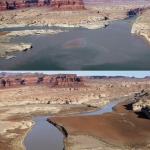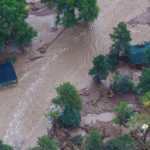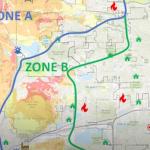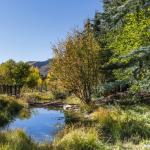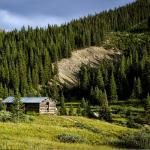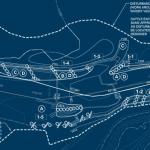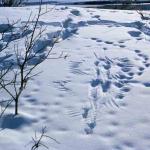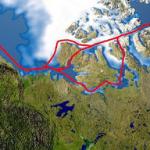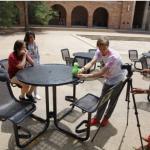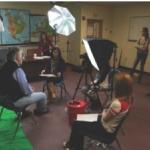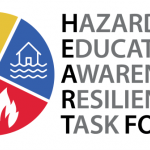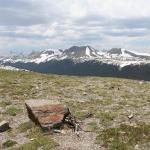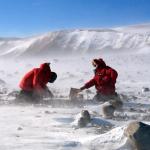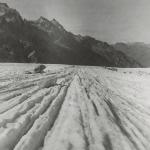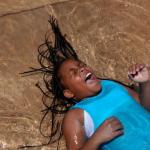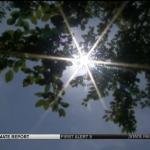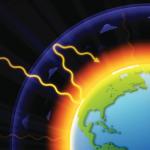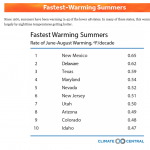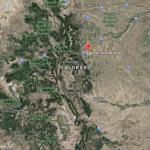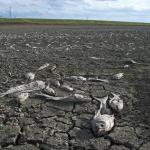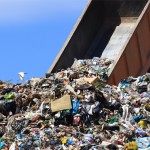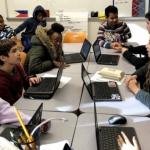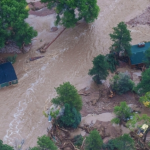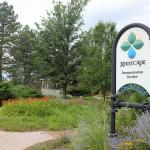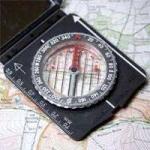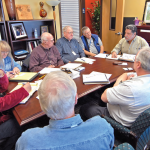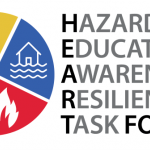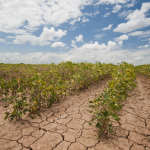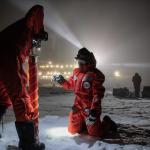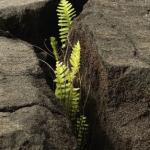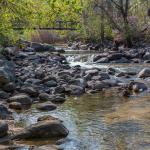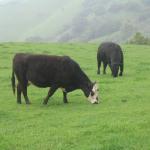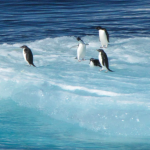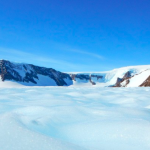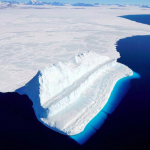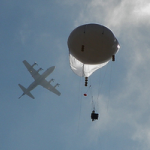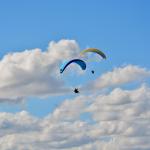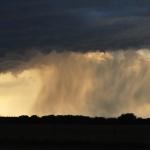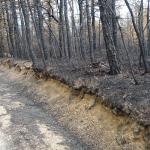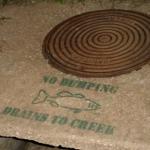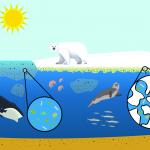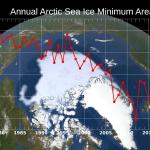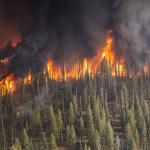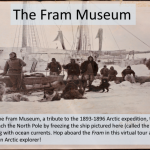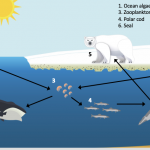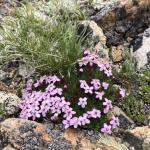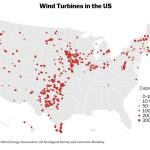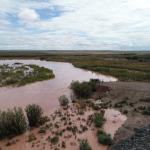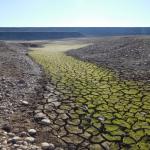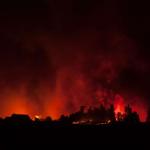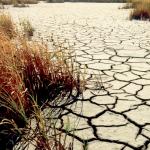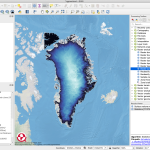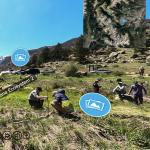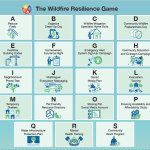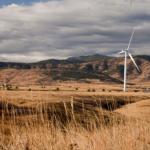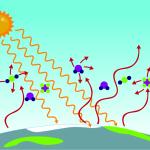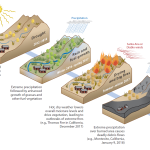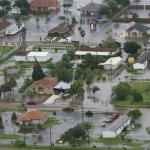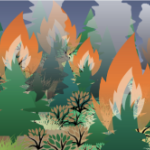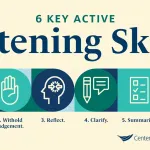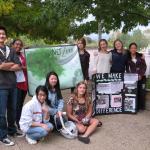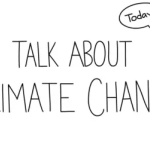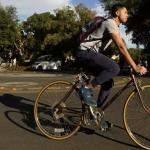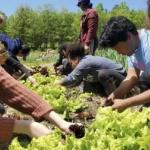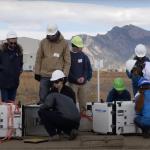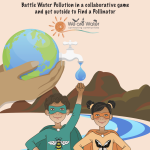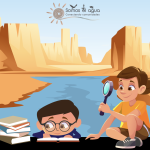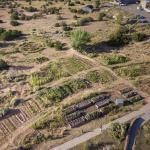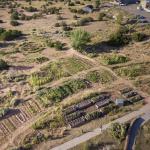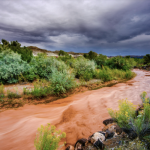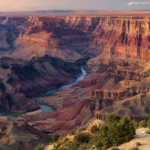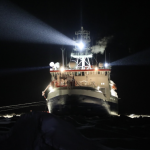Lesson Plans & Activities
A Changing Climate: Understanding Drought in Colorado
This lesson is best taught at the beginning of a HEART Force unit, but it can also act as a stand-alone lesson to introduce students to drought in Colorado.
Students build an understanding of drought in Colorado using multiple data sources in a jigsaw activity.
HEART Force Flood Response Game
This lesson is best used after the Colorado Flood lessons in the HEART Force curricular unit, for students to apply their learning and respond to a hypothetical flood in their own community.
This interactive game has students work in three “zone response teams” to solve community challenges that arise during the course of an extreme flooding event by using available individual and community resources.
The Vocabulary of Hazards
We suggest teaching this lesson to introduce the unit as it will benefit students in their understanding of natural hazards throughout the entire HEART Force Unit.
This lesson uses a matching game to build students' understanding and familiarity with different terms used in the world of resiliency planning.
Envisioning a Resilient Future
We suggest teaching this lesson to introduce the HEART Force Unit.
In this lesson, students create a vision for the future of their community and identify what resources are most important to them as a starting point for resilience planning.
A Changing Climate: Understanding Floods in Colorado
This lesson is best taught at the beginning of a HEART Force unit, but it can also act as a stand-alone lesson to introduce students to floods in Colorado.
Students build an understanding of flooding in Colorado using multiple data sources in a jigsaw format.
A Changing Climate: Understanding Wildfire in Colorado
This lesson is best used as part of the HEART Force curricular unit, but it can also act as a stand-alone lesson to introduce students to wildfire in Colorado.
Students build an understanding of wildfire in Colorado using multiple data sources in a jigsaw format.
HEART Force Wildfire Response Game
This lesson is best used after the wildfire hazard lesson in the HEART Force curricular unit, for students to apply their learning and respond to a hypothetical wildfire in their own community.
In this interactive game, students work in three “zone response teams” to solve community challenges that arise during the course of a wildfire event by using available individual and community resources.
HEART Force Drought Game
This lesson is best used after the Colorado Drought lessons in the HEART Force curricular unit, for students to apply their learning and respond to a hypothetical drought in their own community.
In this interactive game, students work in three "resilience teams" to solve community challenges that arise during the course of an extreme drought event by using available individual and community resources.
Flood Resilience in Colorado StoryMap
This is a lesson that can be used to get ideas and prepare for the Community Resilience Expo.
Students interact with a flood StoryMap to explore the Colorado Resiliency Framework.
Wildfire Resilience in Colorado StoryMap
This is a lesson that can be used to get ideas and prepare for the Community Resilience Expo.
Students interact with a wildfire StoryMap to explore the Colorado Resiliency Framework.
Exploring Local Hazard Mitigation Plans
This lesson is part of the Community Resilience Expo, a culminating event for the HEART Force curriculum unit, where students will share what they’ve learned during the hazard lesson and the role-playing game.
In this lesson, students will explore their county Hazard Mitigation Plan to gain understanding about the hazard in their area (flooding, wildfire, or drought), including historic hazards, probability of future occurrences of the hazard, and vulnerability of the area to the hazard.
Design a Resilient Future
This is a lesson that can be used to get ideas and prepare for the Community Resilience Expo.
In this lesson, students will work in small groups to develop an idea to increase community resilience, utilizing Design Thinking.
Animal Tracks Can Illuminate Many Things: A Detective Exercise
Project EXTREMES lessons were written to be stand alone lessons but can be incorporated into a larger unit.
Having students follow animal tracks (even just people, dogs, or squirrels) and investigating how tracks are made is a fun and exciting way to develop critical thinking, measurement, and graphing skills.
Northwest Passage: Then and Now
Project EXTREMES lessons were written to be stand alone lessons but can be incorporated into a larger unit.
In this lesson, students learn about some of the early explorations of the Northwest Passage, and how the changing sea ice extent has prompted new explorations of this region to transport goods from one region of the Northern Hemisphere to another.
Ice Core Demonstration: The Past is the Key to the Future
Project EXTREMES lessons were written to be stand alone lessons but can be incorporated into a larger unit.
This lesson has students explore how the gases trapped in ice cores over the last quarter of a century can be used to understand how Earth's atmosphere has changed in the past.
Filmmaking: Pre-Production
This is the first part of a 3-part unit on the filmmaking process for both formal and informal education settings.
This lesson has students explore science content, decide on the topic for their film, and do all the preparatory work before filming begins.
Sharing Science with Film: A Guide to Student Productions
The examples and lesson plans provided in the educator guide emphasize scientific film topics; however, the methods shared throughout Sharing Science With Film: A Guide to Student Productions are applicable to films around all topics and genres.
Sharing Science With Film: A Guide to Student Productions is a guide for educators, and provides a how-to manual for instructing youth on how to produce short films.
Filmmaking: Production
This is the second part of a 3-part unit on the filmmaking process for both formal and informal education settings.
In this lesson, students film interviews with content experts as well as additional B-roll footage, and film mentors help students find existing footage and media to supplement their films.
Filmmaking: Post-production
This is the third part of a 3-part unit on the filmmaking process for both formal and informal education settings.
This lesson teaches students about editing films and respecting licensed materials, while also ensuring they receive the support they need to ensure completion of their films.
Community Resilience Expo Overview
The Expo is best taught at the end of HEART Force unit, after students are familiar with the hazard.
The Community Resilience Expo is a culminating event for the HEART Force curriculum, where students will develop and present original ideas to increase resilience in their community.
Exploring the Arctic
This is the first activity of a three-part curriculum about Arctic climate; the activities may be used independently or in sequence.
This activity introduces students to the Arctic and Arctic climate. Through a virtual exploration of the geography of the Arctic students become familiar with the region. They are then introduced to meteorological parameters that Arctic research teams use.Do you really want to visit the Arctic?
This is the second activity of a three-part curriculum about Arctic climate; the activities may be used independently or in sequence.
This jigsaw activity introduces students with Arctic weather data using a role-playing activity that has students read and interpret graphs while considering the optimal time to plan a research mission to the Arctic.Exploring Arctic Climate Data
This is the third activity of a three-part curriculum about Arctic climate; the activities may be used independently or in sequence.
In this final activity, students use authentic Arctic climate data to explore albedo and its relationship to seasonal snowmelt as a self-reinforcing feedback mechanism, which is then applied to large scale global climate change.What’s Up With The Rising Temperatures in Colorado Cities?
This is the first lesson in the Climate Resiliency Education Middle School Climate Unit.
This lesson introduces why certain cities in Colorado are getting hotter using a video by the Denver Post that describes the pattern.What Makes Cities Hotter?
This is the second lesson in the Climate Resiliency Education Middle School Climate Unit.
In this lesson, students explore reasons why temperatures in particular Colorado cities are rising.Why Are Growing Cities Hotter?
This is the third lesson in the Climate Resiliency Education Middle School Climate Unit.
This lesson has students explore what land use changes are happening and how changes in surface color affects temperatures in cities.Are Other Parts of the World Getting Hotter?
This is the fourth lesson in the Climate Resiliency Education Middle School Climate Unit.
In this lesson, students investigate whether other parts of the world are changing and getting hotter just like Colorado.What Was Earth’s Temperature Like in the Past?
This is the fifth lesson in the Climate Resiliency Education Middle School Climate Unit.
Students examine what the world’s temperature trend was in the past and whether temperatures have changed recently.How Does Human Activity Affect the Warming Temperatures on Earth?
This is the sixth lesson in the Climate Resiliency Education Middle School Climate Unit.
This lesson explores whether human activities release greenhouse gases, like CO2, and whether these activities can cause temperatures on Earth to increase.How Do Cars Impact CO2 in the Atmosphere?
This is the seventh lesson in the Climate Resiliency Education Middle School Climate Unit.
During this lesson, students explore how fossil fuel burning in cars contributes CO2 to the atmosphere.How Does an Increase in CO2 Cause an Increase in Temperature?
This is the eighth and final lesson in the Climate Resiliency Education Middle School Climate Unit.
In this lesson, students learn how more CO2 in the atmosphere causes global warming.Why Are Cities Getting Hotter?
This is the first lesson in the Climate Resiliency Education High School Climate Unit.
During this lesson, students explore the increase in summer temperatures and describe the pattern as it relates to Colorado using a video by the Denver Post.What is Special About Cities Compared to Rural Places?
This is the second lesson in the Climate Resiliency Education High School Climate Unit.
This lesson explores climate data at local, national, and global levels to determine that temperatures are changing all over the world, and that there are certain locations where temperatures are warming faster than the global average.Why Are Cities and Other Regions of the World Getting Hotter?
This is the third lesson in the Climate Resiliency Education High School Climate Unit.
This lesson has students investigate how albedo is contributing to temperature increasing in some places, like cities, are increasing at faster rates than elsewhere.How Do Humans Contribute to the Increase in Global Temperatures?
This is the fourth lesson in the Climate Resiliency Education High School Climate Unit.
Students explore the greenhouse effect in this lesson using a computer simulation and develop a model for how it works.Is it Normal That World Temperatures Are Rising This Fast?
This is the fifth lesson in the Climate Resiliency Education High School Climate Unit.
This lesson explores if it is normal that world temperatures are rising at the currently observed fast pace.What Impact do Increasing Greenhouse Gases Have?
This is the sixth and final lesson in the Climate Resiliency Education High School Climate Unit.
In this lesson, students utilize case studies to learn about the ways climate change is currently impacting people and other living things around the world.How Can We Decrease Our Impact on the Earth’s Climate at our School?
This is the first lesson in the Climate Resiliency Education Design Challenge Unit which was designed to follow the middle or high school Climate Resiliency Education units.
In this design challenge lesson students explore the Denver Public School District’s solid waste plan and discuss how their school can save or decrease emissions by reducing solid waste at our school.How Does Our School Food System Create Greenhouse Gas Emissions?
This is the second lesson in the Climate Resiliency Education Design Challenge Unit which is meant to follow the middle or high school Climate Resiliency Education units.
In this design challenge lesson, students examine their school food system and develop an investigation about food waste in order to know what should change.How Can We Understand Waste and Emissions in Our School's Food System?
This is the third lesson in the Climate Resiliency Education Design Challenge Unit which is meant to follow the middle or high school Climate Resiliency Education units.
This lesson outlines for students how to design and carry out an investigation to audit their school’s food waste system.How Can We Reduce Emissions Associated with Food Waste in Our School?
This is the fourth lesson in the Climate Resiliency Education Design Challenge Unit which is meant to follow the middle or high school Climate Resiliency Education units.
In this activity students utilize the data that is collected and propose solutions to mitigate food waste in their school.How Can We Present Solutions for Food Waste and Emissions at School?
This is the fifth lesson in the Climate Resiliency Education Design Challenge Unit which is meant to follow the middle or high school Climate Resiliency Education units.
This lesson provides guidance for students to create and practice a presentation about their design challenge results that they developed in the previous lessons and how to present it to the school administration.What Are The Features of The Sun?
This is the first of four modules/lessons in the SDO curriculum that leads students through an interactive exploration of Solar Science.
In this lesson, students develop a fundamental understanding of NASA’s Solar Dynamic Observatory (SDO) and the Sun’s structure and function.
Adapting to Extremes: Exploring the Science of Floods in Colorado
This lesson is best taught at the beginning of a HEART Force unit, but it can also act as a stand-alone lesson to introduce students to floods in Colorado.
The way we choose to design our communities has impacted community risk and vulnerability to flooding; in this lesson, students will explore this concept by analyzing environmental data to classify patterns and practice communicating their findings.
Adapting to Extremes: Exploring the Science of Wildfire in Colorado
This lesson is best used as part of the HEART Force curricular unit, but it can also act as a stand-alone lesson to introduce students to wildfire in Colorado.
Students build an understanding of wildfire in Colorado using multiple data sources in a jigsaw format.
Wildfire Virtual Expo
This lesson provides a virtual alternative to the HEART Force Expo curriculum.
This is a streamlined lesson for students to prepare for a Community Resilience Expo, focusing on wildfire.
Flood Virtual Expo
This lesson provides a virtual alternative to the HEART Force Expo curriculum.
This is a streamlined lesson for students to prepare for a Community Resilience Expo, focusing on flood.
Drought Virtual Expo
This lesson provides a virtual alternative to the HEART Force Expo curriculum.
This is a streamlined lesson for students to prepare for a Community Resilience Expo, focusing on drought.
Creating a Compass from a Magnet
Project EXTREMES lessons were intended to stand alone, but this lesson can be included in a unit on the Earth’s interior.
In this lesson, students create a compass and apply their reasoning about magnetism to how compasses work to help us navigate around the globe while utilizing the Earth’s magnetic field.
Communicate Existing Plans
This is a guide that can be used for a pathway for the Community Resilience Expo.
In this sub-unit, students will learn more about their community’s resilience plans, choose a specific topic to focus on, and develop a product to communicate the plan to their peers and/or their community.
HEART Force Curriculum Overview
This unit consists of several lessons and can take anywhere from 1 to 6 weeks to teach, depending on which lesson teacher choose to incorporate.
The HEART Force curriculum builds understanding of wildfire, flood, or drought in the context of place-based community resilience.
Adapting to Extremes: Exploring the Science of Drought in Colorado
This lesson is best taught at the beginning of a HEART Force unit, but it can also act as a stand-alone lesson to introduce students to drought in Colorado.
Humans have been affected by severe drought throughout history; in this lesson students explore this concept by analyzing environmental data to classify patterns and practice communicating their findings.
Exploring the New and Old Arctic
This unit consists of 6 lessons, each tied to NGSS nature of science understandings
In this MS/HS unit, students compare and contrast Arctic expeditions of the past (1893-1896 Fram expedition) and the present (2019-2020 MOSAiC expedition) to prepare for the Arctic of the future.Arctic Feedbacks: Not All Warming Is Equal
This storyline unit consists of 10 lessons, each tied to NGSS Earth's systems standards
In this MS/HS unit, students engage with 360° virtual field trips, authentic Arctic datasets, and app-based labs to construct models and explanations for the unit driving question, "Why might the Arctic be warming four times as fast as the rest of the world?"Photosynthesis, Respiration, and the Short-Term Carbon Cycle
Project EXTREMES lessons were written to be stand alone lessons but can be incorporated into a larger unit.
This lesson is focused on the short-term cycling of carbon and is designed to put the processes of photosynthesis and respiration within a global perspective.
Habitat for Stream Insects
Project EXTREMES lessons were written to be stand alone lessons but can be incorporated into a larger unit.
This activity encourages students to collect data to answer questions, explore the roles of individual macroinvertebrates in aquatic ecosystems, and think about the health of aquatic ecosystems relative to the macroinvertebrates found.
In Support of Basic Science
Project EXTREMES lessons were intended to stand alone, and this lesson can be implemented at any time when deemed appropriate, such as the onset of a scientific investigation.
This activity will challenge students thinking about the nature of science and highlight the importance of both basic and applied scientific research.
Energy Pyramids and Food Webs
Project EXTREMES lessons were written to be stand alone lessons but can be incorporated into a larger unit.
In this lesson, students identify the sun as the source of energy and understand how energy flows through an ecosystem.
What do we already know, or think we know, about climate & Antarctica?
This is the first lesson of a five-part curriculum about Antarctic physical environments and ecosystems.
In this lesson, students will elicit initial ideas about climate, explore images of Antarctica, learn important vocabulary, and synthesize how satellite imagery can help us understand climate change in Antarctica.How does the changing climate impact the penguins around Antarctica?
This is the second lesson of a five-part curriculum about Antarctic physical environments and ecosystems.
In this lesson, students investigate the life history characteristics of different Antarctic penguin species and identify the changes that their populations have experienced.Antarctic Life & Albedo
This is the third lesson of a five-part curriculum about Antarctic physical environments and ecosystems.
In this lesson, students explore the importance of albedo (or reflectivity) to penguins and the surfaces they inhabit and learn how penguin colonies may be mapped using satellites.Why does the ice melt on the “Frozen Continent”?
This is the fourth lesson of a five-part curriculum about Antarctic physical environments and ecosystems.
After exploring albedo in the previous lesson, this lesson expands on more factors that lead to surface ice melt in Antarctica.Human Impacts on Climate Change: What will happen and what can we do about it?
This is the fifth lesson of a five-part curriculum about Antarctic physical environments and ecosystems.
In this lesson, students explore how human activities will continue to impact Antarctic ice, discuss human contributions to climate change, and investigate what we can do to stop/reverse these negative effects.Data Analysis: Introduction to Measurement, Error, and Outliers
Project EXTREMES lessons were written to be stand alone lessons but can be incorporated into a larger unit; this lesson can be used to support learners who are new to data collection and analysis.
In this lesson, students measure and compare the rate of a falling object (a penny) at different heights to learn about statistical error.
DISCOVER-AQ Curriculum Overview
The four DISCOVER-AQ modules can be completed independently, sequentially, or extended into a larger unit of study.
The DISCOVER-AQ curriculum integrates real-word research with real-life learning to answer the question: What are the causes and effects of air quality issues and how do they affect human health and the environment?

Air Quality: More than Meets the Eye
The four DISCOVER-AQ modules can be completed independently, sequentially, or extended into a larger unit of study.
In this module, students engage in a visual demonstration on the causes & effects of air pollutants on air quality and kinesthetic activities on particulate matter & visibility.
Oh No, O3zone: “Good Up High, Bad Nearby!”
The four DISCOVER-AQ modules can be completed independently, sequentially, or extended into a larger unit of study.
This module teaches students about ozone’s role in the atmosphere and explores authentic data to compare and contrast conditions that affect ground-level ozone values.
Sherlock NOx: The Mystery of Unnatural Pollution in Natural Places
The four DISCOVER-AQ modules can be completed independently, sequentially, or extended into a larger unit of study.
Students take virtual field trips to explore air quality research sites and investigate the causes, effects, and solutions to nitrogen deposition in Rocky Mountain National Park during this module.
Carbon Gases CSI: Mobile Lab, Methane & More
The four DISCOVER-AQ modules can be completed independently, sequentially, or extended into a larger unit of study.
During this module, students take a virtual mobile lab drive with scientists to investigate and learn about atmospheric carbon gases, their sources, and impacts on air quality.
Precipitation Patterns Around the Globe
Project EXTREMES lessons were written to be stand alone lessons but can be incorporated into a larger unit.
Students apply their knowledge of the water cycle to investigate how annual precipitation patterns are related to geography and biology.
Soil Percolation: Where Does the Rain Go?
Project EXTREMES lessons were written to be stand alone lessons but can be incorporated into a larger unit.
This lesson activity has students conduct an experiment that reinforces one component of the water cycle.
Waste, Water, and Wastewater
Project EXTREMES lessons were written to be stand alone lessons but can be incorporated into a larger unit.
In this lesson, students will apply what they know about how to separate a mixture by designing a wastewater treatment facility that effectively removes contaminants.
Population Estimates: Bringing Math and Science Together
Project EXTREMES lessons were written to be stand alone lessons, but this activity may be used prior to a field study to provide students with practice in estimating or used in a unit on ecosystems.
During this activity students will learn how to estimate population size using two techniques, density extrapolation and the mark-recapture method.
The Future of Forests
This storyline unit consists of 9 lessons, each tied to NGSS life science standards
In this middle school unit supported by NASA, students engage with online interactives, authentic datasets, and citizen science protocols to construct models and explanations for the unit driving question, "How do landscapes recover after a wildfire?"A Changing Arctic Ecosystem
This storyline unit consists of 8 lessons, each tied to NGSS life science standards
The Arctic is warming more rapidly than anywhere else on Earth. One consequence of a warming Arctic is a dramatic decline in sea ice, an important habitat for many Arctic plants and animals. In this unit students will engage with 360° virtual reality tours, hands-on labs, and authentic Arctic datasets as they gather evidence to construct explanatory models for the unit driving question, "How might the decline in sea ice affect Arctic organisms large and small?"Data Puzzle: On a Budget
This data puzzle is a stand-alone lesson that is part of a larger collection of data puzzles.
The Arctic is currently warming at a rate faster than the global average, a phenomenon known as Arctic amplification. In this Data Puzzle, students analyze authentic Arctic datasets to construct explanatory models for the following question, "Why might the Arctic be warming faster than other places on Earth?"
Data Puzzle: Balancing Act
This data puzzle is a stand-alone lesson that is part of a larger collection of data puzzles.
Since the early 2000s, the Greenland Ice Sheet’s mass balance has been consistently negative, meaning more mass is being lost than gained. But this change in mass balance hasn’t always happened at the same rate. What could account for observed changes to the amount of ice in the Greenland Ice Sheet in recent decades?
Data Puzzle: To Reflect or Not to Reflect
This data puzzle is a stand-alone lesson that is part of a larger collection of data puzzles.
The color of Earth's surface determines how much of the Sun's energy is reflected or absorbed, where lighter-colored surfaces are more reflective (higher albedo). In this Data Puzzle, students analyze authentic Arctic data to construct explanatory models for the following question, "How might the Arctic’s albedo be affected by the observed decline in sea ice?"
Data Puzzle: It's All Connected
This data puzzle is a stand-alone lesson that is part of a larger collection of data puzzles.
What makes the Arctic climate system so unique is the sea ice, which influences the Arctic climate in many ways. In this Data Puzzle, students analyze authentic Arctic data to construct explanatory models for the following question, "What effect, if any, do leads (cracks in the sea ice) have on the transfer of moisture between the Arctic Ocean and atmosphere?"
Data Puzzle: Megafire - Rare Occurrences or the New Normal?
This data puzzle is a stand-alone lesson that is part of a larger collection of data puzzles.
Megafires have been a hot topic in the news over the past few years, but are they a new phenomenon? In this Data Puzzle, students analyze authentic wildfire data to construct explanatory models for the follow question, "How and why has the number of megafires have changed over time?"
VR Expedition: Explore the Arctic Aboard The Fram
This is part of a collection of VR experiences.
Take a virtual stroll through the Fram and learn all about Nansen and his crew's adventures in the Arctic with this virtual expedition. This is a stand-alone resource that is part of a MOSAiC VR collection.Data Puzzle: Megadrought in the Colorado River Basin
This data puzzle is a stand-alone lesson that is part of a larger collection of data puzzles.
Much of the western United States is experiencing drought conditions. In this Data Puzzle, students analyze authentic climate data to construct explanatory models for the following question, "What is causing the megadrought in the Colorado River Basin?"
Data Puzzle: What's the Limit?
This data puzzle is a stand-alone lesson that is part of a larger collection of data puzzles.
Moss campion is a hearty flowering plant that thrives in harsh arctic and alpine tundra ecosystems over a wide range of latitudes in North America. In this Data Puzzle, students analyze authentic moss campion growth and survival data to construct explanatory models for the following question, "How is the growth and survival of moss campion affected by latitude?"
VR Expedition: MOSAiC Ice Camp
Take a virtual tour of the MOSAiC Ice Camp in this virtual experience. This is a stand-alone resource that is part of a MOSAiC VR collection.VR Expedition: MOSAiC Distributed Network
Take a virtual tour of the MOSAiC Distributed Network, Fedorov, in this virtual experience. This is a stand-alone resource that is part of a MOSAiC VR collectionData Puzzle: Tracing Carbon Through the Arctic Food Web
This data puzzle is a stand-alone lesson that is part of a larger collection of data puzzles.
The Arctic is home to a huge variety of living things (humans included) that have adapted to harsh conditions. However, these conditions are changing as Arctic temperatures rise and sea ice declines. In this Data Puzzle, students trace the flow of carbon through the Arctic food web to construct explanatory models for the following question, "How might the decline in sea ice affect Arctic organisms large and small?"

Data Puzzle: The Tipping Point
This data puzzle is a stand-alone lesson that is part of a larger collection of data puzzles.
Plants like moss campion are uniquely adapted to the cold, dry climate characteristic of the tundra biome...but temperatures are on the rise. In this Data Puzzle, students analyze temperature and reproduction data to construct explanatory models for the following question "How is moss campion reproduction affected by temperature?"
PolarPASS Interactive Environments
Using real data, diverse material types, and a range of activities, PolarPASS modules are designed to bring polar science and exploration to the classroom. PolarPASS modules link to Climate Literacy Principles and Polar Literacy Principles and are being tested in teaching models that include semester, quarter, and block teaching models.
Polar Space and Places, or PolarPASS, is connecting polar-focused material with innovative teaching methods to advance STEM undergraduate education and increase polar knowledge.
Data Puzzle: Wind Farms of the Future
This data puzzle is a stand-alone lesson that is part of a larger collection of data puzzles.
Transitioning from fossil fuels to clean, renewable energy sources like wind is essential if the US is to reduce its carbon emissions. But where should new wind farms be constructed? In this Data Puzzle, students analyze surface roughness and wind speed data to construct an evidence-based explanation for the following question, "Where in the United States (lands and waters) should new wind turbines be constructed to generate the most energy?"
Geomagnetism Challenge
This lesson is centered around a data challenge using the CrowdMag application. The challenge includes live webinars, asynchronous videos, lesson plans, and the chance to win a raffle! The lessons and asynchronous videos can be used as stand-alone resources.
Individuals and classrooms are invited to join the GeoMag Data Challenge! Explore the power of community/citizen science, Earth's magnetic field, and data collection with us.
Middle School Wildfire Unit
This HEART Force curricular unit includes all lessons for the Middle School Wildfire curriculum.
The HEART Force curriculum builds an understanding of wildfire, flood, or drought in the context of place-based community resilience.
Middle School Flood Unit
This HEART Force curricular unit includes all lessons for the Middle School Flood curriculum.
The HEART Force curriculum builds an understanding of wildfire, flood, or drought in the context of place-based community resilience.
Middle School Drought Unit
This HEART Force curricular unit includes all lessons for the Middle School Drought curriculum.
The HEART Force curriculum builds an understanding of wildfire, flood, or drought in the context of place-based community resilience.
High School Wildfire Unit
This HEART Force curricular unit includes all lessons for the High School Wildfire curriculum.
The HEART Force Curriculum builds an understanding of wildfire, flood, or drought in the context of place-based community resilience.
High School Flood Unit
This HEART Force curricular unit includes all lessons for the High School Flood curriculum.
The HEART Force curriculum builds an understanding of wildfire, flood, or drought in the context of place-based community resilience.
High School Drought Unit
This HEART Force curricular unit includes all lessons for the High School Drought curriculum.
The HEART Force curriculum builds an understanding of fire, flood, or drought in the context of place-based community resilience.
From Greenland to our Coasts: Exploring Sea Level Change with QGreenland
This unit consists of 3 lessons, each tied to NGSS life science standards
In this unit, students will explore how the Greenland Ice Sheet is changing and why that affects coastal communities worldwide. Students will view authentic Greenland geospatial data and learn how to create flood maps to assess local risk in QGIS.
Ecosystems of Rocky Mountain National Park
This virtual reality tour is part of a larger lesson focused on ecosystems.
Students explore biotic and abiotic interactions in Rocky Mountain National Park ecosystems in this virtual reality tour.Geomagnetism: Earth's Magnetic Field
In two lessons, designed for grades 6-12, students will explore how Earth’s magnetic field protects us from harmful space weather that can damage communications systems, disrupt navigation systems, and overwhelm the electric grid.
Analyzing Geomagnetism using the CrowdMag App
This lesson is a stand-alone lesson for undergraduate students. Measure the background geomagnetic field of your campus, Identify anomalies created by local magnetic sources, and compare geomagnetic data collected by different devices.
HEART Force Wildfire Resilience Game
This lesson is best used after the wildfire hazard lesson in the HEART Force curricular unit, for students to apply their learning and recover from a hypothetical wildfire in their own community.
In this scenario-based role-play game, students play the role of community members planning for wildfire resilience in their community. After a wildfire occurs, they see how resilience and recovery efforts pan out in their hometown based on their planning efforts.
Shifting Winds
In this short unit, students investigate the question "Are wind patterns at the foot of the Rocky Mountains changing?" Students explore what causes wind and look at recent wind data. Students create a public-facing infographic to explain to the public if and how wind patterns are changing.Data Puzzle: Not All Warming is Equal
This data puzzle is a stand-alone lesson that is part of a larger collection of data puzzles.
The dramatic increase in atmospheric carbon dioxide has caused global temperatures to rise by more than 1.1°C (~2°F), but not all warming is equal. In this Data Puzzle, students analyze temperature and atmospheric carbon dioxide datasets to construct explanatory models for the following question, "Do the places on Earth where temperatures are increasing the most also have the greatest increases in atmospheric carbon dioxide?"
Drifting North Polar Planetarium
In this MS/HS lesson, students will be transported to the Arctic with the MOSAiC expedition, The Multidisciplinary drifting Observatory for the Arctic Climate, in an immersive classroom and field trip experience.ReVisioning Hazards
This is the first lesson in the Lake County Cascading Hazards unit, but can be used for any introduction to natural hazards curriculum.
In the first lesson of the Lake County Cascading Hazards Unit, students read a poem written by a local fire survivor, and utilize a visualization practice to build personal resilience.Cascading Hazards
This is the second of four lessons in the Lake County Cascading Hazards unit.
In the second lesson of the Lake County Cascading Hazards unit, students dig into local stories and datasets, and learn about the connections between natural hazards.Take Action
This is the last of four lessons in the Lake County Cascading Hazards unit.
In the last lesson of the Lake County unit, students develop idea to increase resilience to hazards in their own community.Lake County Cascading Hazards Unit
The unit has four lessons in total.
This unit builds an understanding of five natural hazards and their connections in the context of place-based community resilience.Social Vulnerability to Natural Hazards
This is the third of four lessons in the Lake County Cascading Hazards unit. This lesson can also be used in the HEART Force Curriculum.
In the third lesson of the Lake County Cascading Hazards unit, students learn about social factors that might make one group more vulnerable to a hazard than another.Data Puzzle: Wildfire, Drought, and the Future of Forests
This data puzzle is a stand-alone lesson that is part of a larger collection of data puzzles.
Wildfires are burning more and more of the forests across the western United States. In this Data Puzzle, Data Puzzle, students analyze post-fire forest recovery datasets as they gather evidence to construct explanatory models for the following question, "How do climate conditions impact the recovery of forests after a wildfire?"
The Emotions Wheel
This activity is a stand-alone exercise part of seven activities from the Climate Mental Health Support Activities.
Emotion wheels have been a visual tool used by psychologists for decades to help people better understand and interpret their feelings. This activity is for people of all ages and can be done with family members, in a classroom, with friends, work colleagues, etc.
Active Listening Skills
This activity is one of seven activities in the Climate Mental Health Support Activities.
In this lesson, students will identify emotions they experience as they learn about the impacts of climate change. In pairs, students will practice active listening skills as one student describes their emotions to the partner who applies active listening skills. They then flip roles and the other student describes their emotions while the partner listens.
Facilitating Discussions and Creating Solidarity
This activity is one of seven activities in the Climate Mental Health Support Activities.
Talking about emotions related to climate change can help youth to process emotions, move on, and develop trust and connection with others through shared solidarity. In this lesson, students will discuss their thoughts and feelings about climate change with others. Consider teaching the Emotions Wheel and Active Listening activities before this in order to help students develop language and discussion skills.
Nature Appreciation
This activity is one of seven activities in the Climate Mental Health Support Activities.
In this lesson, students will play, explore, appreciate, and practice perspective-taking in nature. All of these actions help positively connect youth to nature, and instill an ethic of care for the environment.
Data Puzzle: Snow in the Rockies
Water from snowmelt high in the Rocky Mountains feeds into the Colorado River, a river system that more than 40 million people rely on for water. In this Data Puzzle, students analyze snowfall and snowmelt datasets to investigate the question, "How have snow conditions in the East River Watershed changed over time?"
Connecting with Special Places in Nature
This activity is one of seven activities in the Climate Mental Health Support Activities.
In this lesson, students will take time to connect to a place that is special to them.
Visioning Possibility
This activity is a standalone exercise that is part of one of seven activities from the Climate Mental Health Support Activities.
In this lesson, students will find inspiration from innovative solutions, envisioning a hopeful future and their role in it.
Climate Solutions
This activity is a standalone exercise that is part of one of seven activities from the Climate Mental Health Support Activities.
In this lesson, students will participate in a short scavenger hunt to familiarize themselves with climate change mitigation strategies and solutions for decreasing heat-trapping emissions.
You are a Climate Leader
This activity is a stand-alone exercise part of seven activities from the Climate Mental Health Support Activities.
In this lesson, students will read brief biographies of youth climate activists and then reflect on how they can take climate action in their own lives. This lesson is best suited as the end of a unit or lesson on climate change as it requires some background knowledge on the causes of current climate change and potential mitigations or solutions.
Data Puzzle: Windstorms on the Front Range
Although strong windstorms are a common weather event at the foot of the Rocky Mountains, a record-breaking windy spring soon after the Marshall Fire disaster had the public feeling on-edge. In this Data Puzzle, students analyze data on the number of windstorms and the number of red flag warnings to investigate the question, “Is it getting windier on the Front Range as the climate warms?”
Module 1: Exploring the Glacier Basin System
This Module consists of five Units, walking students through an overview of the glacier basin system, exploring glacier mass balance, albedo, and surface melt, and looking inside and underneath the glacier. The Units also cover the transition from the glacier margin to land and system responses to climate change.
Earth's polar environments have undergone rapid change during the 21st century and scientists have generated important new data and made groundbreaking insights. Despite growing interest to bring polar-focused material into the undergraduate classroom, curriculum development has lagged. Polar Space and Places, or PolarPASS, is connecting polar-focused material with innovative teaching methods to advance STEM undergraduate education and increase polar knowledge.
Module 2: Long-term Spatial Transformations of the Glacier Basin System
Module 2 is designed to follow after Module 1. Instructors may choose to use Module 2 independently, but may want to consider some additional introductory materials if they are not beginning with Module 1. Module 2 consists of four Units. The Units begin by exploring past ice margin retreat and processes of ice margin retreat and elevation change. The material then explores natural climate variability and anthropogenic forcings, and then examines potential future ice margin response to climate change.
Earth's polar environments have undergone rapid change during the 21st century and scientists have generated important new data and made groundbreaking insights. Despite growing interest to bring polar-focused material into the undergraduate classroom, curriculum development has lagged. Polar Space and Places, or PolarPASS, is connecting polar-focused material with innovative teaching methods to advance STEM undergraduate education and increase polar knowledge.
Be a Water Detective Take & Make Kit
This Take & Make Kit will help you become a water detective so that you can tell the story of water in your community!
Student's use tools to make observations about how water shapes the surface of our planet and how water supports and is impacted by the life that calls Earth home. Through these observations, water detectives are able tell meaningful stories about water.Sé un detective del agua | Be a Water Detective Take & Make Kit
This Take & Make Kit will help you become a water detective so that you can tell the story of water in your community!
Ser un detective del agua significa ser un buen observador. Los y las detectives del agua se fijan no solo en cómo el agua cambia la superficie de nuestro planeta, pero también en cómo el agua soporta la vida terrestre y es en turno afectada a su por los seres vivos que llaman a la Tierra su hogar.Be a Water Ecosystem Hero Take & Make Kit
This Take & Make Kit will help you become a water ecosystem hero that can battle water pollution, protect our rivers, and recognize pollinators in your local environment!
Student's work together to protect a river from water pollution in a collaborative board game, search for evidence of pollinators in their backyard, and learn about the connections between water, pollution and pollinators.Sé un héroe del ecosistema del agua | Be a Water Ecosystem Hero Take & Make Kit
This Take & Make Kit will help you become a water ecosystem hero that can battle water pollution, protect our rivers, and recognize pollinators in your local environment!
Combate la contaminación del agua jugando en equipo y sal de casa para buscar un polinizador.Be a Water Historian Take & Make Kit
This Take & Make Kit will help you become a water historian so you can share recorded stories with people in your community and elsewhere in the Four Corners region through the We are Water project!
Everyone has a story to tell. Recording stories from your family, friends, and people in your community is an important part of understanding history in your town. In this activity, students learn how to be a good interviewer so that they can help preserve amazing stories from their community!Sé un/a Historiador/a del Agua | Be a Water Historian Take & Make Kit
This Take & Make Kit will help you become a water historian so you can share recorded stories with people in your community and elsewhere in the Four Corners region through the We are Water project!
Toda persona tiene una historia que contar. Registrar las historias de tus familiares y amigos y las personas de tu comunidad es fundamental para conocer la historia de tu pueblo. Esta actividad le enseña a ser un/a buen/a entrevistador/a.Tó daniidlį' nilį' | Be a Water Historian Take & Make Kit
This Take & Make Kit will help you become a water historian so you can share recorded stories with people in your community and elsewhere in the Four Corners region through the We are Water project!
Everyone has a story to tell. Recording stories from your family, friends, and people in your community is an important part of understanding history in your town. In this activity, students learn how to be a good interviewer so that they can help preserve amazing stories from their community!Waffle Garden Take & Make Kit
This Take & Make Kit will help you understand ancient Indigenous agricultural techniques, including science and math skills that are still effective in modern times!
Indigenous peoples of the American Southwest, including the Diné (Navajo), A:shiwi (Zuni), Zia Pueblo, and Laguna Pueblo, have been using a time-tested agricultural method known as a waffle garden to successfully grow crops in the semi-arid environment for generations. In this activity student's will reflect upon and learn about Indigenous relationships with water and the land to help them understand diverse methods of using water in dry climates.Un jardín de forma de wafle | Waffle Garden Take & Make Kit
This Take & Make Kit will help you understand ancient Indigenous agricultural techniques, including science and math skills that are still effective in modern times!
La gente indígena del suroeste de los Estados Unidos, incluyendo los Diné (Navajo), A:shiwi (Zuni), Zia Pueblo y Laguna Pueblo, han utilizado durante generaciones un método agrícola de probada eficacia conocido como Un jardín de forma de wafle para cultivar con éxito en el entorno semiárido. En esta actividad, los estudiantes reflexionarán y aprenderán sobre las relaciones indígenas con el agua y la tierra para ayudarlos a comprender diversos métodos de uso del agua en climas secos.Watershed Stewardship Patch Activity
Earn a We Are Water Patch by becoming familiar with your local watershed!
We can be good watershed stewards by taking positive actions that will help to ensure the watershed’s healthy functions. In this activity, students learn how to be good watershed stewards and become familiar with their local watershed through observation, positive action, and community engagement.Actividad del parche sé protector de la cuenca | Watershed Stewardship Patch Activity
Earn a We Are Water Patch by becoming familiar with your local watershed!
We can be good watershed stewards by taking positive actions that will help to ensure the watershed’s healthy functions. In this activity, students learn how to be good watershed stewards and become familiar with their local watershed through observation, positive action, and community engagement.Conversation Guide: Our Relationship with Water
This structured conversation guide is a great way to begin a dialogue about shared experiences with water in your community!
In this conversation, participants will explore their shared watershed and local ecosystems, and connect with neighbors through their common and unique experiences with water in the region. We hope individuals, families, and communities will share their memories and stories about water and come together to imagine a future they want for their communities.Guía de Conversación: Nuestra Relación con el Agua | Conversation Guide: Our Relationship with Water
This structured conversation guide is a great way to begin a dialogue about shared experiences with water in your community!
En esta conversación, los participantes van a discutir su cuenca compartida y conectar a través de sus experiencias únicas y compartidas sobre el agua en la región. Esperamos que los participantes compartan sus recuerdos e historias sobre el agua y que se junten para imaginar el futuro que quieren para sus comunidades.Stop Motion Animation Workshop
Learn how to create a short (<1 minute) stop-motion animation of a story!
This workshop is designed to be completed in two days or two sessions. Each portion is about 1.5 – 2 hours long. You may want to leave time between sessions for students to make their pieces. Depending on how intricate their story is, they may need more time for cutting out shapes, making “characters,” etc.We are Water Kahoot Trivia - Beginner Level
Answer some fun trivia questions about the science of water and the geography of the Four Corners Region! Pick a level where you want to start and see how far you can go!
Challenge your students with beginner level trivia from We are Water about the science of water and the geography of the Four Corners Region.We are Water Kahoot Trivia - Intermediate Level
Answer some fun trivia questions about the science of water and the geography of the Four Corners Region! Pick a level where you want to start and see how far you can go!
Challenge your students with intermediate level trivia from We are Water about the science of water and the geography of the Four Corners Region.We are Water Kahoot Trivia - Advanced Level
Answer some fun trivia questions about the science of water and the geography of the Four Corners Region! Pick a level where you want to start and see how far you can go!
Challenge your students with advanced level trivia from We are Water about the science of water and the geography of the Four Corners Region.We are Water Kahoot Trivia - Expert Level
Answer some fun trivia questions about the science of water and the geography of the Four Corners Region! Pick a level where you want to start and see how far you can go!
Challenge your students with expert level trivia from We are Water about the science of water and the geography of the Four Corners Region.Introduction to the MOSAiC Expedition
Introduction to the MOSAiC Expedition is one of four activities in the The Drifting North Polar Planetarium Experience that invites students to explore what it was like to participate in the MOSAiC expedition to the North Pole.
In this activity, students will learn about the conditions in the Arctic and the scientists who study them through slides, audio podcast, and a worksheet. Learning will be guided with the driving questions: What is the Arctic? Who studies the Arctic? and Why should we care about the Arctic?Letters to the Arctic
Letters to the Arctic is one of four activities in the The Drifting North Polar Planetarium Experience that invites students to explore what it was like to participate in the MOSAiC expedition to the North Pole.
In this activity, students put themselves in the shoes of a scientist who works in a fragile and changing environment. Learning will be guided with the driving question: How do scientists feel about the places they study?Seasons and Light in the Arctic
Seasons and Light in the Arctic is one of four activities in the The Drifting North Polar Planetarium Experience that invites students to explore what it was like to participate in the MOSAiC expedition to the North Pole.
In this activity, student's will explore why we have seasons and changing daylight throughout the year by graphing different daylight hours around the world. Learning will be guided with the driving question: How do we understand the Arctic light and seasons?Sea Ice, The Character
Sea Ice, The Character is one of four activities in the The Drifting North Polar Planetarium Experience that invites students to explore what it was like to participate in the MOSAiC expedition to the North Pole.
In this activity, student's will compare and contrast the different structures of freshwater ice and seawater ice with a hands-on lab. Learning about what makes sea ice so unique in the Arctic will be guided by the driving questions: How does saltwater sea ice differ from freshwater ice? What is sea ice like in the Arctic? and Why is sea ice important in the Arctic?